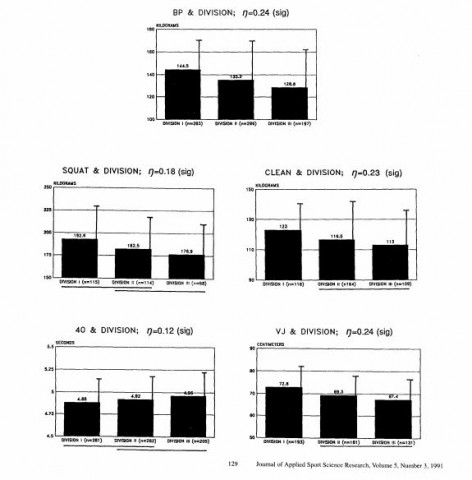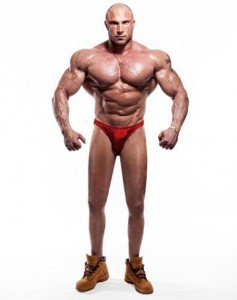I remember back in high school playing basketball. And we had a coach that tended to go with the older players as starters and bring in the underclassmen as subs. Looking back our coach probably had his reasons for his line-up. Older players would graduate soon and this would be their last year to play high school ball. Or maybe the older players had more experience and a longer relationship with the coach. And it's possible that the older players were simply bigger and stronger and got more playing time as a result. Seeing as how a year later, when I graduated high school, tipping the scales at a buck fifty, I wasn't going to be intimidating anyone on the court with my physical presence. But this didn't help my competitive nature and desire to be a starter and on the floor getting more playing time. Maybe if I were a little more on top of the literature back then I could have advocated for myself by hitting the weight room a little more frequently. Actually, who's kidding who? I never hit the weight room at all as a high school athlete. But I probably should have. Because the truth is that stronger athletes: play at a higher levelget more playing time But this isn't just an opinion but findings from a research study by Fry & Kramer (citation below) that looked at a number of performance tests of American college football players playing NCAA Division I, II and III. In total 19 NCAA programs participated in the study involving almost a thousand players (n=981). The authors of the study looked at five performance tests and compared this to level of play (i.e. Division I, II or III) and playing time (starter v. non-starter). The performance tests they looked at included:...
Stretch For Increased Strength Gains
- Chris Collins
- Fitness
- 1934 Hits
- 0 Comments
-
Did you ever have quizzes when you were in school?I'm talking about surprises quizzes that were given without advance notice.[caption id="attachment_5529" align="aligncenter" width="300"] Pop quizzes were a good way to assess how well the class learned the basics.Usually they didn't count much toward your final grade but were important to get a quick pulse on how the class was doing. Did they learn the previous lesson? Can the teacher proceed with more advanced concepts?In other words, does the class understand the basics?Well, guess what it's quiz time!And the question is what is something most people want when it comes to their training but will neglect as well?The answer of course is stretching.And I would guess the reason stretching gets little attention is that it's not as appealing as a good strength or energy system training session.Bodybuilders, power and Olympic lifters all like the pump after a good lift.Aerobic athletes seek out 'the high' they get from a good ride, run, hike or swim.And once we've gotten what we need out of the training session there isn't much interest in stretching. It gets pushed to the side and ignored.But the irony is more and more people identify flexibility and mobility as their goal for training. Maybe they have restricted mobility which impacts their quality of life. For example, maybe a lack of shoulder mobility impairs an individual's ability to sleep at night. They may have nagging low back pain from tight hips and a weak core.So we know what we need but for whatever reason we are reluctant to give stretching and mobility the attention it deserves in our training program.This may be partly due to the fact most people train for a fat loss goal. They train to look better. They train to change the aesthetic which then helps with confidence and...
Train at Least 3 Times per Week
- Chris Collins
- Fitness
- 1815 Hits
- 0 Comments
-
Have you ever heard the term muscle-confusion? This is commonly used in the marketing pieces of fitness centres to tell you how you'll get better results by doing something different all the time. The premise is that when you do the same activity repeatedly the body 'learns' what you're doing and thus doesn't spend as much energy in order to do. While there is some neuromuscular efficiency that occurs with training it doesn't necessarily lead to the best results. One thing is certain when you perform new movements all the time. You are really sore after doing the first of whatever sport activity you're going to do. Think of how your butt feels after the first long ride on a skinny bike seat. Or how your legs feel after the first heavy powder ski day of the year. Or how your forearms after the first time going rock climbing. Yes it's true. New sports and activity will induce soreness. But I have yet to have one person come through the door of Okanagan Peak Performance Inc identifying soreness as their goal. Or to be sweaty. Or out of breath. How do we know that muscle confusion doesn't work? Because of the research. Recently I was down to Spokane for a conference and had the opportunity to see James Krieger present. During his presentation he showed a study that compared training frequency on size and strength gains. And there were a couple of interesting things about this study. James was the co-author of this study along with Brad Schoenfeld. For those that aren't familiar with Mr. Schoenfeld he is known for producing a lot of great of research on strength training. He is also contracted by the New Jersey Devils. I believe James's role in this paper was to handle the statistics....
40% Better Results w/ Coach vs. DIY
- Chris Collins
- Fitness
- 1608 Hits
- 0 Comments
-
I remember back when we were building our house. We had decided to do a natural rock wall and stairs in our backyard using some huge boulders. When the guy who was going to build the wall showed up and rang the door bell I wasn't sure if I should open the door or call Crime Stoppers.[caption id="attachment_5396" align="aligncenter" width="300"] My reaction when I saw the wall builder show up.But as it turned out he was legit and built a beautiful wall in our backyard.Now as this was during the summer and I was home for the day I offered to help the guy out. Although he had some heavy equipment to move all the boulders around I figured there would be benefit to a second set of hands.My thoughts were that this guy would probably appreciate the help. And maybe the job would go more smoothly. And if the job took less time because I was helping him maybe it would shave a little of the bill time-wise. Because as some of you know building a home isn't cheap.So I offered to help. And this is what the guy said.'It's 50% more if you watch. Double if you help.'Roger that. Alexandra packed up some food, drinks and a blanket and we headed to the beach.But home build projects aren't the only areas where we might be tempted to lend a hand or DIY (do it yourself). We all know lots of examples where people do their own investing. They take care of their own vehicles. They log on to Web MD to diagnose whatever ails them. And a number of people will look to take after their health and fitness on their own as well.But what kind of results can you get on your own compared to using a coach? Can...
Strength - How Much is Enough?
- Chris Collins
- Fitness
- 1866 Hits
- 0 Comments
-
There are a number of things we can do to improve our health and fitness. Strength training is one of the more popular options.And it's not an uncommon goal to hear people new to exercise describe their goal as wanting to get stronger.'I'd like to have stronger arms' says the woman as she massages the back of her triceps.'I'd like to be able to do a pull-up' says the female athlete trying out for a new team.'I'd like to deadlift xxx pounds' says the business executive that wants to be able to test himself in a gym setting.And these are all reasonable goals. But after we've trained for an appreciable amount of time e.g. 6-12 months, we notice the gains start slowing or stop altogether.For example, the person that has never deadlifted could pull 135 lbs in their first month. And it's not unreasonable to hit 225 lbs by their third month. This progress won't continue linearly for the rest of the year. In other words if three months is a quarter of the year we can't expect this person to increase their deadlift to four-times their three month total by the end of the year. This would result in a 900 lbs deadlift. That's not happening.So we get it that our strength has limits and that the gains come more quickly at the beginning.But at point should would be satisfied with our strength? When is enough strength, enough?Well, if you're a competitive lifter you're never satisfied with enough. You're always seeking an extra kilo on the bar or maybe a second rep at your max load.This is because the higher we get in a competitive field the harder it is to continually improve. Track and field shows us numerous examples of this. In the 100 m race it's not uncommon for...
Lift Heavy or Lift Lots?
- Chris Collins
- Fitness
- 1969 Hits
- 0 Comments
-
There can always be a number of ways to achieve a result. As the expression goes, many roads lead to Rome. But the more specific we can be with our goal the more specific we can be with the prescription.With resistance training the question can often be one of should I do lighter weights and more reps or heavier weights and fewer reps? And typically the average person will be led to believe that lifting heavy weights makes you big and bulky and so they select lighter weights in order to tone and not get big.[caption id="attachment_5301" align="aligncenter" width="300"] Often times people will select light weights with the goal to tighten and tone while looking to avoid increased mass.But this isn't the best approach. If we think about the group that trains to put on the most size i.e. bodybuilders, they will typically train with higher volume (i.e. reps x sets) to stimulate a hypertrophy (i.e. growth) response.Additionally, the people that train most intensely e.g. sprinters, will have some of the leanest physiques out there.So there appears to be some confusion as to what we should do to get leaner and or stronger.A study by Mangine et al. 2015 looked at the effect of volume and intensity when it comes to developing size or strength. The study included 29 resistance-trained men and ran for 8 weeks.The participants were divided into two groups. One group followed a high intensity protocol by performing exercises in the 3-5 rep range or approximately 90% of their 1 rep max (RM). Three minutes of rest was allowed between sets.The other group followed a high volume protocol with exercises performed in the 10-12 rep range or approximately 70% of their 1 RM. One minute of rest was allowed between sets.Here's what they found.The high intensity group made larger...
How to Fix a Strength Plateau
- Chris Collins
- Fitness
- 1963 Hits
- 0 Comments
-
Anyone that does resistance training does so with the goal of getting stronger. Individuals coming off an injury want to get back to regular activity as soon as possible and do this by increasing the strength of the supportive muscles.Individuals with a weight loss goal understand that increased strength will lead to added muscle mass. And this extra muscle mass becomes the metabolic furnace to burn extra calories when we're not in the gym training.Athletes as well train to increase strength as this helps them minimize the potential for injury as well as enhance performance in sport. A stronger athlete can typically produce force more quickly than a weaker athlete which provides an athletic advantage in terms of speed. As well, when an athlete is stronger this does wonders for their confidence which can translate to better performance during games.So how do we typically go about getting stronger?[caption id="attachment_4907" align="aligncenter" width="300"] Increased strength benefits all training goals.Well one of the first protocols for strength was developed by Dr. DeLorme who helped rehab injured soldiers. DeLorme noticed the soldiers recovered more quickly and completely when given a strength training protocol as part of their rehab.I'm going to go out on a limb and say you probably know what the protocol was...Finish the following...'3 sets of ___ reps'.If you said 10 reps, you'd be right. That's the training plan for the DeLorme protocol.And it worked really well. In the short term.Over time however, it doesn't yield the results it did in the beginning. And this should come as no big surprise to anyone reading this. Consider the following example.Mary is new to weight training and has just learned how to do a trapbar deadlift. For the month of May Mary does 3 sets of 10 reps with 75 lbs on the bar. Each...
Corrective Exercise Gone Bad
- Chris Collins
- Training
- 2365 Hits
- 29 Comments
-
Did you ever watch those tv specials 'When Animals Go Bad'?You know the ones I mean? They show video footage of a normally docile and affectionate pet or animal that just snaps and some poor unsuspecting soul pays the price for it?I remember seeing an animal handler have a koala bear freak out at Busch Gardens in Tampa once. The little kids that were so curious to see this cute bear all rushed the handler and surrounded him quickly.And if you can imagine to a koala bear seeing all these little monsters running at it and screaming the koala bear thinks it's getting attacked.So the koala starts clawing at the handler to get away. The bear doesn't want to be held by the handler while all these little people are charging forward.And up until that point I never realized that koalas have sharp claws. But after seeing the handler get sliced and diced by the koala I don't think of these animals as cute and cuddly anymore.Long story short the koala ended up back in its habitat. And the handler was taken away on a stretcher for stitches and medical treatment.So what the heck does this have to do with training and fitness?Well just like at the zoo sometimes we have different intentions of the final outcome.In this case the koala bear, the handler and the little kids all hoped things would have turned out a little differently.The handler probably didn't forsee a trip to the hospital for stitches and maybe a shot.The bear didn't forsee what it perceived as an apparent attack.And the little kids didn't realize they wouldn't be able to pet the bear and were a little distraught to see the bear attack the handler and be wisked away shortly after still snarling and trying to defend itself.Now back to the gym.Imagine...
5 Things I Can Do Better to Improve My Health & Performance
- Chris Collins
- Fitness
- 1774 Hits
- 5 Comments
-
If you're serious about your health and performance than you want to know that you're doing the best you can with your efforts. And if you're not where you'd like to be weight-wise, performance-wise or in terms of your rehab than there are probably some things you could be doing a better job of. And if you are having some success in these areas than you are probably motivated to see what else you could do to ramp up your results even more.I'll be honest...I know I could do more personally. A while back I stated some of my goals. A few of them included hitting targeted strength measures, improved fitness levels and a specific scale weight.And while I'm on track to hit my goals I know I could be further along. I know I maybe under-estimated myself by selecting goals I knew I had a pretty good chance of attaining.There's not a problem in doing that. But we want to make sure we are giving our best effort and setting new goals if necessary.So while I'll probably wait until I realize the current goals I've set until I pick new ones there are a few things I know I can improve on until then. With that in mind here are 5 Things I Can Do Better to Improve My Health & Performance.1. Improved sleep - I need 8 hours of sleep a night. Not 8 hours of bedtime on my computer, reading or doing sudoku puzzles but 8 actual hours of sleep. I need to make sure that I get as many of these 8 before midnight as possible. And I need to make sure to be as consistent with my time to bed and time to rise as possible.2. More soft tissue work - Every workout should begin with some foam...






